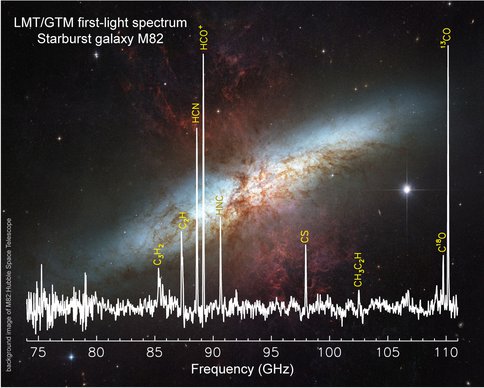2011 Annual Science Report
 NASA Goddard Space Flight Center
Reporting | SEP 2010 – AUG 2011
NASA Goddard Space Flight Center
Reporting | SEP 2010 – AUG 2011
An Encyclopedia of Astrobiology and Using the Large Millimeter Telescope for Astrobiological Observations
Project Summary
Irvine and colleagues at the University of Massachusetts have begun commissioning the Large Millimeter Telescope, the largest single-dish radio telescope in the world operating at short millimeter wavelengths. This is a joint project with the country of Mexico.
Project Progress
GCA Co-Investigator Prof. William M. Irvine spent significant time as an Editor of a new Encyclopedia of Astrobiology published by Springer. The Encyclopedia contains some 1800 entries on the variety of fields which constitute astrobiology, including astronomy, physics, chemistry, biochemistry, geology, biology, microbiology, planetary science, and history of science. Hundreds of authors have contributed entries, which range from short (~ 100 words), through medium (500 words) and long (~ 1600 words), to overviews (6000 words plus references). Each entry received three separate reviews, from a specialist in the field, a non-specialist (to ensure readability for those outside the immediate field of the author), and the responsible editor. Irvine himself contributed some 90 entries and was responsible for those sections of the Encyclopedia dealing with astrochemistry and planetary science. In addition, he was a specialist or a non-specialist reviewer for several hundred other entries, and he participated in reading proofs for a wide range of entries. The Encyclopedia has now been published (Gargaud et al. 2011), in both on-line and printed format.
GCA Co-Investigator Prof. William M. Irvine and colleagues at the University of Massachusetts Amherst have achieved first light at millimeter-wavelengths with the Large Millimeter Telescope (LMT), sited in Mexico at an altitude of 4600 meters (15,000 feet). The LMT will be a powerful instrument for various fields within astrobiology, including the study of the chemistry and physics of comets and other primitive bodies in the solar system, of planetary and satellite atmospheres, and of organic molecules in the interstellar medium of the Milky Way and other galaxies (See Facilities, below).
Administrative Activities Related to Astrobiology:
Irvine continued as President of the International Astronomical Union’s Commission 51, Bioastronomy. A primary responsibility was planning a joint meeting (entitled Origins 2011) of Bioastronomy with ISSOL-The International Astrobiology Society, held in Montpellier, France, in July 2011. This conference was a major venue for astrobiology discussion and interaction. More than 400 scientists attended, giving some 50 oral presentations and more than 300 posters. Its success is exemplified by the decision to hold another such joint meeting in 2014; an invitation to host this conference has been accepted from Japan. Irvine is collaborating on the initial planning with ISSOL President David Deamer and with the Japanese Local Organizing Committee.
Facilities:
The Large Millimeter Telescope (LMT) is a joint project of the University of Massachusetts Amherst and the country of Mexico, whose portion of the project is administered by the Instituto Nacional de Astrofisica, Optica y Electronica (INAOE) in Tonantzintla, Puebla, Mexico. First light has recently been achieved with the inner 32 meters of the main reflector, as illustrated in Figure 1. Both the 144-element bolometer array AzTEC and the heterodyne Redshift Search Receiver (36 GHz instantaneous bandwidth at 3mm wavelength) are installed in the receiver cabin. The LMT is the largest single-dish telescope in the world operating at short millimeter wavelengths. It will be augmented to a full 50 m diameter with funding promised by the Mexican science agency CONACyT. Irvine is a Special Assistant to the Vice-Chancellor for Research at the University of Massachusetts Amherst, with responsibility for promoting closer cooperation between the US and Mexican teams working on the project. He will insure that astrobiological research opportunities for the telescope are appreciated and taken into account in plans for instrumentation and operation.
Commissioning activities are underway at the telescope. These include improving the setting of the surface with the aid of holography, tuning the active surface for gravitational and thermal effects, defining the telescope pointing, implementing the full servo-system, integrating new instruments into the system, and initial astronomical observations.
Outreach:
Displays about the LMT continue to be presented at the annual fall fair in Cuidad Cerdan, a city about 18 km from the base of the mountain where the LMT is cited in Mexico.
Figure 1. First light spectrum obtained by the Large Millimeter Telescope/Gran Telescopio Milimétrico. The millimeter-wave emission from the starburst galaxy Messier 82 is superimposed on an image of the galaxy obtained by the Hubble Space Telescope. Emission from specific molecular species appears as spikes in the spectrum, allowing astronomers to probe the physical conditions and chemical makeup of the gas where stars are forming in the galaxy. Among the molecules detected are isotopic variants of carbon monoxide (CO), hydrogen cyanide (HCN), hydrogen isocyanide (HNC), carbon monosulfide (CS) and the abundant interstellar molecular ion HCO+.
-
PROJECT INVESTIGATORS:
-
RELATED OBJECTIVES:
Objective 3.1
Sources of prebiotic materials and catalysts
